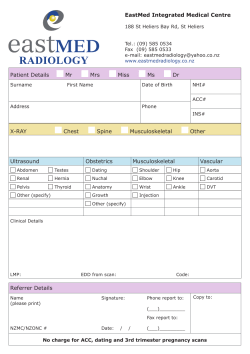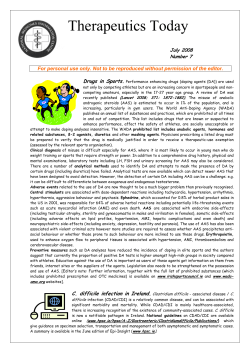
I M S
INVESTIGATION AND MANAGEMENT OF SCABIES IN LONG TERM CARE FACILITIES AND OTHER HEALTH CARE FACILITIES Colorado Department of Public Health and Environment Communicable Disease Epidemiology Section – (303) 692-2700 What Types of Facilities do these Guidelines Cover? This document provides guidance for investigating, treating, controlling, and preventing scabies in long term care facilities (LTCFs) and other health care and residential facilities such as assisted living residences (ALRs), residential care facilities for the developmentally disabled, and acute and transitional care units. As the arrangement of these facilities can vary tremendously, local public health agencies and affected facilities can contact the CDPHE Communicable Disease Epidemiology Section (303-692-2700) for further guidance. What is Scabies? • AGENT: Human scabies (Sarcoptes scabiei var. hominis) is a microscopic mite that burrows into the upper layer of skin where it lives and lays its eggs. Scabies occurs worldwide and affects people of all races and social classes. Institutional settings such as LTCFs, hospitals, and other health care settings are at increased risk of scabies outbreaks due to underlying medical conditions of patients, close living quarters, and frequent skin-toskin contact between patients and staff members. Outbreaks in these settings can be difficult to control and require a rapid, aggressive, and sustained response. • INCUBATION PERIOD: The time between contact with the mite and the appearance of symptoms varies. If a person has never had scabies before, symptoms typically appear two to six weeks after initial exposure. If a person has had scabies before, symptoms can occur one to four days following mite exposure. • DURATION: Left untreated, symptoms may continue indefinitely. After receiving appropriate treatment, symptoms (especially itching) may continue for several weeks, but will gradually disappear. • SYMPTOMS: The most common signs and symptoms of a typical scabies infestation are intense itching (pruritus), especially at night, and a pimple-like (papular) itchy rash. The rash may contain tiny blisters (vesicles) and scales. Tiny, raised, crooked grayish-white or skin-colored burrows are sometimes seen on the skin; the burrows can be a centimeter or more in length. The itching and rash may affect any part of the body, or may be limited to common sites like the webbing between the fingers, wrist, elbow, armpit, shoulder blades, breasts, waist, genitals, buttocks, and knees. Skin sores and secondary bacterial skin infections can occur due to scratching of affected areas. Institutional settings, including health care settings, should maintain a high index of suspicion that undiagnosed skin rashes and conditions may be scabies. • CRUSTED SCABIES: Patients of LTCFs and other health care facilities are at higher risk of scabies hyperinfestation known as crusted scabies (also referred to as Norwegian, atypical, or keratotic scabies). Persons with crusted scabies are very contagious, so a single patient or staff member with crusted scabies can easily lead to an outbreak in the facility. Typically, only 10 to 15 mites are present on the entire body of a person with a typical scabies infestation; a person with crusted scabies can be infested with thousands or millions of mites. Persons with crusted scabies may not show the usual scabies signs and symptoms; lesions from crusted scabies may resemble psoriasis (thick, red, scaly patches/crusts on the skin). Steroid treatment, inability to scratch, or immune compromising conditions are common in persons with crusted scabies. Persons with crusted scabies should receive quick and aggressive medical treatment for their infestation. Updated May 2013 Page 1 of 9 • TRANSMISSION/COMMUNICABILITY: Scabies is transmitted primarily through prolonged, direct skin-toskin contact with an infested person, and may also be transmitted through shared clothing, towels, bedding, linens, carpets, and furniture. An infested person can spread scabies even if he/she does not have symptoms, and can continue to transmit scabies to others until treatment is successful and all mites and eggs are destroyed. On a person, scabies mites can live for as long as one to two months. Mites survive 2 to 5 days on surfaces (off a person). A person is no longer considered contagious 24 hours after start of effective treatment. Scabies can spread rapidly under conditions where frequent skin-to-skin contact occurs, such between patients and caregivers in health care facilities. Animals do not spread human scabies (animals can be infested with different types of scabies that may cause a mild, self-limited infestation in humans; however, animal scabies to not multiply in humans). • DIAGNOSIS: Diagnosis is usually made based on symptoms. Whenever possible, the scabies diagnosis should be confirmed in an affected person by identifying the mite, mite eggs, or mite fecal matter (scybala). This can be done by a health care provider experienced at obtaining a skin scraping to examine under a microscope. A person can still be infested even if mites, eggs, or fecal matter are not found. • TREATMENT: Scabies treatment is described on page 4 of this document. Health Care Facility Regulation in Colorado and Public Health Reporting Requirements: The CDPHE Health Facilities and Emergency Medical Services Division (HFEMSD) maintains licensing and regulatory authority over health care facilities, and conducts routine inspections and complaint investigations. In contrast, outbreaks of illness at such facilities are investigated by the Communicable Disease Epidemiology Section (CDES) at CDPHE or by the appropriate local public health agency (per Colorado Revised Statute 25-1-506). Group outbreaks from any source are reportable to public health; facilities should report suspected scabies outbreaks to the local public health agency or state health department (303-692-2700) within 24 hours so that appropriate control measures can be implemented as quickly as possible. An isolated, individual case of scabies infestation is not a public health reportable condition in Colorado; however, facilities can consult with public health to ensure appropriate prevention and control measures are implemented so an outbreak does not occur. If a local public health agency learns of an outbreak in a health care facility, please report the outbreak to the CDPHE CDES (via email or call 303-692-2700) as soon as possible. Scabies Case Definitions and Outbreak Definition: When investigating an individual case of scabies or an outbreak of scabies, the following definitions are used to classify suspected cases, confirmed cases, and contacts: • Suspected case: A person with signs and symptoms consistent with scabies. • Confirmed case: A person who has a skin scraping in which mites, mite eggs or mite feces have been identified by a trained health care professional. • Contact: A person without signs and symptoms consistent with scabies who has had direct contact (particularly prolonged, direct, skin-to-skin contact) with a suspected or confirmed case in the two months preceding the onset of scabies signs and symptoms in the case. For the purposes of these guidelines, a scabies outbreak is defined as at least two cases (any combination of suspected or confirmed cases) identified in patients, staff, volunteers, or visitors during a two week period of time. Scabies outbreaks in health care facilities may be prolonged due to the contagious nature of the mite and the fact that persons can spread the mite to others before he/she has symptoms. If a single patient is diagnosed with crusted scabies, the health care facility is at significant risk of an outbreak. Updated May 2013 Page 2 of 9 General Scabies Prevention Measures: General scabies prevention measures are listed below. Additional prevention and control measures to implement for single cases, outbreaks, and for crusted scabies are outlined on the following pages. • Establish a surveillance system for skin rashes in the facility for early detection of potential scabies cases in patients and staff. Early detection and treatment of cases are essential in preventing outbreaks. o Educate all staff about scabies. o Maintain a high index of suspicion that scabies may be the cause of undiagnosed skin rash. o Screen all new patients and staff for skin rashes that may be compatible with scabies to try to prevent scabies from entering a facility. • For LTCFs and residential facilities with licensed health care staff: Ensure that the facility has access to scabies diagnostic services. o Consult with an experienced dermatologist for assistance in differentiating skin rashes and confirming the diagnosis of scabies. o Have at least one health care staff member trained and experienced in obtaining skin scrapings, which can be then be examined by a health care provider experienced in diagnosing scabies. • Vacuuming, routine laundering, and general cleanliness provides adequate environmental prevention. Additional Information: For additional information on scabies, please visit the Centers for Disease Control and Prevention scabies website: http://www.cdc.gov/parasites/scabies/ • Pictures of scabies mites in a skin scraping: http://www.dpd.cdc.gov/dpdx/HTML/ImageLibrary/Scabies_il.htm • Pictures of scabies rash: http://www.skinsight.com/adult/scabies.htm Single Case and Outbreaks of Non-Crusted (Typical) Scabies If a single case of non-crusted scabies is diagnosed at a facility, or an outbreak of non-crusted scabies is identified, the actions outlined below are recommended. Typically, by the time a scabies outbreak is detected, transmission has likely been occurring for weeks to months. Because crusted scabies is highly transmissible, additional investigation, treatment, prevention, and control measures may be necessary (see page 6). INVESTIGATION: o Detecting and tracking suspect and confirmed cases: • If scabies is suspected in a patient or staff member, the skin rash should be examined by a trained health care professional and skin scraping testing should occur (often conducted by a dermatologist). In ALRs, patients with suspected scabies should be referred to their primary care provider. It is helpful if the ALR alerts the primary care provider about the suspicion of scabies so a referral can be made to a dermatologist, if warranted. • Maintain heightened surveillance in the facility for at least two months to detect potential new cases. • For tracking purposes, maintain a line list of symptomatic patients and staff that tracks name, age, sex, unit/wing/room number (for patients), job duty (for staff), date signs/symptoms were first recognized, symptoms, body part affected, skin scraping status and results, and whether treatment was received. Sample line lists can be found on pages 7 (for staff) and 8 (for patients). This data will help determine the level of risk for other patients and staff, the extent of the outbreak, and how cases may be related (by person, place, and time). • Notify other institutions which an infested patient may have transferred to or from within the two months prior to recognizing signs/symptoms in the patient. • If staff who are determined to be cases work at other health care facilities, each facility should be notified of the staff person’s scabies infestation. Updated May 2013 Page 3 of 9 o Contact Investigation: • For each patient and staff diagnosed with suspected or confirmed scabies, determine who had direct contact (particularly those who have had prolonged, direct skin-to-skin contact) with him/her in the two months preceding the onset of scabies signs and symptoms. Treatment is recommended for these contacts, even if the contacts do not have signs and symptoms. See page 9 of this document for a form to help track this information. Follow the treatment guidelines below for these persons. When determining contacts, be sure to consider: Health care facility staff (primarily caregivers; consider cleaning/laundry staff if they had direct contact with clothing, linens, towels, etc. used by the symptomatic person) Therapists/specialists, including those offsite (such as at day programs, therapy clinics, etc.) Visitors Other patients/residents Volunteers Sexual partners Roommates Family members/household members • Attempt to notify contacts who are no longer at the facility of the potential scabies exposure. • If an indentified contact has been transferred to a different health care facility, notify that facility. • If staff determined to contacts work at other health care facilities, each facility should be notified of the staff person’s scabies exposure. o Additional investigative duties if an outbreak is occurring: • Contact CDPHE (303-692-2700) or your local public health agency to report the outbreak. Public health can provide guidance for the investigation. • Designate a person at the facility who is in charge of the outbreak. • Institute facility-wide screening (for all patients and staff) to detect other possible infested persons. • Maintain surveillance for new cases for two months after recognition of the last symptomatic patient or staff. • Depending on the extent of the outbreak, consider halting new admissions until suspected and confirmed cases and identified contacts have been treated. TREATMENT – Suspected or Confirmed Cases: o If the patient is diagnosed with suspected or confirmed scabies, he/she should receive prompt treatment. Risk associated with scabies treatment is generally very low. o Retreatment one to two weeks following the initial treatment may be recommended by a health care provider if symptoms continue or if a new rash or burrows appear. (It is common that a patient with suspected or confirmed scabies is treated twice, especially if the patient has underlying medical conditions or other circumstances that may make it difficult to determine if symptoms are continuing.) o The recommended treatment for scabies is 5% permethrin scabicide cream (Elimite®), which is available with a prescription. No “over-the-counter” (non-prescription) products have been tested and approved to treat human scabies. • Carefully follow the instructions for application provided by the treating health care provider and/or pharmacist. The scabicide cream is typically applied prior to bedtime and must cover all skin areas from the neck down including skin folds and crevices. The cream should be reapplied to body parts that are cleansed or become moist following application. • After the recommended length of application (per the health care provider and/or pharmacist), treated persons must shower or bathe to remove the scabicide. • Clothing and linens used during treatment should be changed and laundered in hot water and dried using the hot cycle. • Skin-to-skin contact with infested persons should be avoided if possible for 24 hours after treatment. o Alternative treatments are available for persons with infestations that do not resolve with typical treatment or for persons with crusted scabies; consult with a health care provider in these situations. Updated May 2013 Page 4 of 9 TREATMENT – Contacts to Suspected or Confirmed Cases: o Contacts to a suspected or confirmed scabies case should be treated at the same time as the case to prevent reinfestation. • Persons treated for scabies (whether they were symptomatic or contacts to an infested person) can usually return to work/school/child care 24 hours after treatment. • Retreatment of contacts one to two weeks following the initial treatment is generally not needed. • Family/household members of contacts should talk to a health care professional about whether treatment is necessary; treatment of these persons should be considered, especially if the contact had extensive prolonged, direct, skin-to-skin contact with a confirmed case of scabies. PREVENTION AND CONTROL MEASURES: o If a patient is suspected of having scabies, he/she should be placed on contact precautions until he/she can be examined by a trained health care professional. If the scabies is confirmed, contact precautions should continue until 24 hours after the initial treatment. Contact precautions for all staff and visitors include: • If available, the patient should be housed in a single-patient room. • Staff/visitors should wear gloves and gowns when entering the room, and especially when touching the patient in order to avoid direct physical skin-to-skin contact. Ensure that gloves and gowns are changed between patients. • Staff/visitors should wear gloves and gowns when handling the patient’s clothing, linens, or bedding materials. Ensure that gloves and gowns are changed before handling another patient’s clothing, linens, or bedding materials. • Staff/visitors should practice good hand hygiene. • Limit the transport of the patient outside of the patient’s room unless required for medical purposes. • When possible, avoid sharing medical equipment (like blood pressure cuffs) between an infested patient and other patients. If equipment must be shared, it should be cleaned and disinfected between patients (normal cleaning procedures and disinfectants can be used). o If a staff member is suspected of having scabies, the staff member should not return to work until he/she can be examined by a trained health care professional. If scabies is diagnosed, then the staff member can return to work 24 hours after appropriate treatment has occurred. • Symptomatic staff members that receive treatment should wear gloves and gowns while providing handson care to patients until they are sure they are no longer infested. o Contacts to a suspected or confirmed case of scabies who have undergone treatment should wear gloves and gowns while providing hands-on care to patients until they are sure they are no longer infested o Clothing, bedding, and linens used by an infested individual during the seven days prior to and during treatment should be laundered in hot water and dried using the hot cycle, or dry cleaned. Scabies mites will die if exposed to a temperature of 122°F for 10 minutes. • Items that cannot be laundered or dry-cleaned such as shoes and coats should be placed in a plastic bag and sealed for seven days. o Fumigation and use of insecticide sprays in living areas is unnecessary. o Routine cleaning and vacuuming of living areas should be conducted. o Update and educate all staff on the situation and related control measures. Updated May 2013 Page 5 of 9 Single or Multiple Crusted (Atypical) Scabies Cases Persons with crusted scabies are infested with a large number of mites, which increases the risk of transmission from brief skin-to-skin contact and from contact with items such as bedding, clothing, furniture, rugs, carpeting, floors, and other objects that can become contaminated with skin scales and crusts shed by person with crusted scabies. If a facility has a case of crusted scabies, the investigation, treatment, prevention, and control measures listed above for “single cases/outbreaks of non-crusted (typical) scabies” and should be followed in addition to the procedures listed below: o Patients diagnosed with crusted scabies typically require two treatments one week apart. These patients should remain on contact precautions until skin scrapings are negative. o Patients with crusted scabies must be placed in a single-patient room if at all possible, due to the increased risk of transmission. o Assign a cohort of caretakers for patients with crusted scabies to reduce further transmission. o Limit visitors for patients with crusted scabies. Visitors should use the same contact precautions and protective clothing as staff. o Strongly consider treating all patients and staff in the facility, regardless of whether they are determined to be contacts to the crusted scabies case. Controlling an outbreak involving a case of crusted scabies can be very difficult, and the risk associated with scabies treatment is low. • All persons who receive treatment (regardless of whether they had scabies symptoms) should launder clothing, bedding, and linens used during the seven days prior to treatment in hot water and dried using the hot cycle, or dry cleaned. Items that cannot be laundered or dry-cleaned such as shoes and coats should be placed in a plastic bag and sealed for seven days. o Ensure that bedding and clothing used by a person with crusted scabies is collected and transported in a plastic bag and emptied directly into the washer to avoid contaminating other surfaces and items. Ensure that laundry staff use protective garments and gloves when handling contaminated items. o Thoroughly clean the room of patients with crusted scabies regularly (vacuuming and regular cleaning procedures are appropriate). If the patient with crusted scabies leaves the facility or moves to a new room, ensure the room the patient was in is thoroughly cleaned and vacuumed prior to a new patient occupying the room. Updated May 2013 Page 6 of 9 SCABIES SURVEILLANCE FORM – STAFF Facility: ________________________________________________________________________________________________ NAME Symptoms: R = Rash AGE I = Itching SEX (M / F) UNIT ASSIGNMENT OR JOB DUTY SYMPTOM ONSET DATE SYMPTOMS (SEE BELOW) BODY PART AFFECTED SKIN SCRAPING RESULTS (POS / NEG / NOT DONE) O = Other (please list) Note: This form is for health care facility use and does not need to be submitted to public health, unless public health requests it. Updated May 2013 Page 7 of 9 TREATED (Y / N, INCLUDE DATE) SCABIES SURVEILLANCE FORM – PATIENTS Facility: ____________________________________________________________________________________________________ NAME Symptoms: R = Rash AGE I = Itching SEX (M / F) UNIT/ WING ROOM # SYMPTOM ONSET DATE SYMPTOMS (SEE BELOW) BODY PART AFFECTED SKIN SCRAPING RESULTS (POS / NEG / NOT DONE) O = Other (please list) Note: This form is for health care facility use and does not need to be submitted to public health, unless public health requests it. Updated May 2013 Page 8 of 9 TREATED (Y / N, INCLUDE DATE) SCABIES CONTACT TRACKING SHEET Name of patient/staff with suspected or confirmed scabies: _____________________________________________________ (For patients): Unit/Wing: ______________________ Room #: _____________________________ Date scabies symptoms recognized: ___________________ Date two months prior to symptom recognition date: _____________________ For the two month time period between the date scabies symptoms were recognized and the date two months prior to symptom recognition date, list who had direct contact (especially prolonged, direct skin-to-skin contact) with the patient/staff member with suspected or confirmed scabies. Treatment of these persons is recommended, even if he/she does not have scabies signs and symptoms. Consider the following persons when identifying potential contacts: • Health care facility staff (primarily caregivers; consider staff whose primary duties are cleaning/laundry if they had direct contact with clothing, linens, towels, etc. used by the symptomatic person) • Therapists/specialists, including those offsite (such as at day programs, therapy clinics, etc.) • Roommates • Other patients/residents • Sexual partners • Visitors • Family members/household members • Volunteers CONTACT NAME RELATIONSHIP TO CASE DATES CONTACT WITH CASE OCCURRED DESCRIBE CONTACT SCABIES SYMPTOMS (Y / N) TREATED (Y / N) TREATMENT DATE Note: This form is for health care facility use and does not need to be submitted to public health, unless public health requests it. Updated May 2013 Page 9 of 9
© Copyright 2025
















